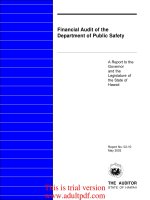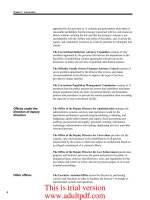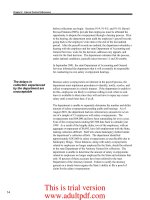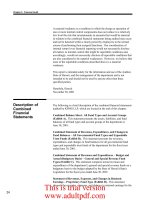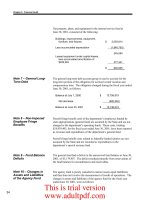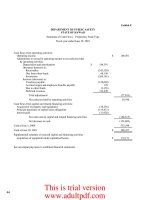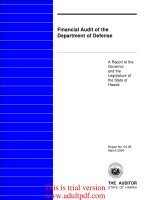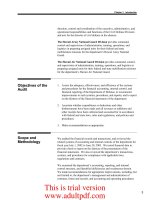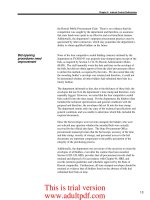Financial Audit of the Department of Defense A Report to the Governor and the Legislature of the State of Hawaii_part4 ppt
Bạn đang xem bản rút gọn của tài liệu. Xem và tải ngay bản đầy đủ của tài liệu tại đây (43.94 KB, 10 trang )
23
Chapter 3: Financial Audit
The following is a brief description of the basic financial statements
audited by PricewaterhouseCoopers LLP, which are presented at the end
of this chapter.
Government-Wide Financial Statements
Statement of Net Assets (Exhibit 3.1). This statement presents assets,
liabilities, and net assets of the department at June 30, 2003 using the
accrual basis of accounting. This approach includes reporting not just
current assets and liabilities, but also capital assets and long-term
liabilities. The department’s net assets are classified as either invested in
capital assets or unrestricted.
Statement of Activities (Exhibit 3.2). This statement presents
revenues, expenses, and changes in net assets of the department for the
year ended June 30, 2003, using the accrual basis of accounting and
presents a comparison between direct expenses and program revenues.
Under this approach, revenues are recorded when earned and expenses
are recorded at the time liabilities are incurred, regardless of when the
related cash flows take place.
Fund Financial Statements
Balance Sheet – Governmental Funds (Exhibit 3.3). This statement
presents assets, liabilities, and fund balances by major governmental
fund and the aggregate remaining fund information using the current
financial resources measurement focus and modified accrual basis of
accounting. Because the emphasis of this statement is on current
financial resources, capital assets, and long-term liabilities are not
reported.
Statement of Revenues, Expenditures and Changes in Fund Balances
– Governmental Funds (Exhibit 3.4). This statement presents
revenues, expenditures, and changes in fund balances by major
governmental fund and the aggregate remaining fund information using
the current financial resources measurement focus and modified accrual
basis of accounting. Under this approach, revenues are recognized when
measurable and available, while expenditures are recorded when the
related fund liability is incurred.
These statements compare actual revenues and expenditures of the
department’s general and major special revenue funds on a budgetary
basis to the budget adopted by the State Legislature for the year ended
June 30, 2003.
Description of
Basic Financial
Statements
Basic financial
statements
Budgetary comparison
statements (Exhibits 3.5
and 3.6)
This is trial version
www.adultpdf.com
24
Chapter 3: Financial Audit
Explanatory notes that are pertinent to an understanding of the basic
financial statements and financial condition of the department are
discussed in this section.
Reporting Entity
The Department of Defense is a department of the State of Hawaii and
provides for the safety, welfare, and defense of the people of Hawaii by
maintaining readiness to respond in the event of war or disaster. Its
divisions include the Hawaii Army and Air National Guards, Civil
Defense, and Office of Veterans Services.
The financial statements of the department present the financial position
and the changes in financial position of only that portion of the
governmental activities, each major fund, and the aggregate remaining
fund information of the State that are attributable to the transactions of
the department. The State Comptroller maintains the central accounts
for all state funds and publishes comprehensive financial statements for
the State annually, which include the department’s financial activities.
Measurement Focus, Basis of Accounting and Financial Statement
Presentation
The accounting policies of the department conform to accounting
principles generally accepted in the United States of America as
prescribed by the Governmental Accounting Standards Board (GASB)
through its statements and interpretations. The government-wide
statement of net assets and statement of activities are accounted for on a
flow of economic resources measurement focus. With this measurement
focus, all assets and liabilities associated with the operation of these
activities are included on the statement of net assets.
The accounts of the department are organized and operated on a fund
basis. Each fund is a separate fiscal and accounting entity, consisting of
self-balancing accounts that comprise its assets, liabilities, fund balance,
revenues and expenditures, as appropriate. The funds are segregated for
the purpose of carrying on specific activities or attaining certain
objectives. The department uses governmental-fund types.
Governmental-fund types are those through which the acquisition, use
and balances of the department’s expendable available financial
resources and the related liabilities are accounted for. The measurement
focus is upon the availability and use of resources and of changes in
financial position rather than upon net income determination. With this
measurement focus, only current assets and liabilities are generally
Notes to Basic
Financial
Statements
Note 1 – Financial
Statement Presentation
Note 2 – Summary of
Significant Accounting
Policies
This is trial version
www.adultpdf.com
25
Chapter 3: Financial Audit
included on the balance sheet. The revenues and expenditures represent
increases and decreases in net current assets. The following are the
department’s governmental-fund types:
General Fund – accounts for all financial activities of the department,
except those required to be accounted for in another fund. The general
fund presented is a part of the State’s general fund and is limited only to
those appropriations and obligations of the department.
Special Revenue Funds – account for the proceeds of specific revenue
sources (other than major capital projects) that are legally restricted to be
expended for specified purposes. The department’s major special
revenue funds are as follows:
Air and Army National Guard – accounts for revenues and expenditures
of providing operations and maintenance projects.
Disaster assistance – accounts for revenues from and expenditures for
providing disaster assistance in the State of Hawaii.
Emergency management performance grant – accounts for revenues
from and expenditures for providing emergency preparedness in the State
of Hawaii.
National Guard Civilian Youth Opportunity – accounts for revenues
from and expenditures for providing youth programs.
Capital Project Funds – account for financial resources to be used for the
acquisition or construction of major capital facilities. The department’s
major capital project funds are as follows:
Veteran Center Cemetery – accounts for financial resources to be used
for the acquisition or construction of major capital facilities of the
cemetery.
Regional Training Center – accounts for financial resources restricted
for the construction or acquisition of the structures at the training site.
All governmental-fund types are accounted for using the modified
accrual basis of accounting. Under the modified accrual basis of
accounting, revenues are recorded when susceptible to accrual, that is,
both measurable and available, usually when the appropriations are
allotted. Expenditures are generally recognized when the related liability
is incurred, except for accumulated unpaid vacation and workers
compensation benefits, which are recognized as expenditures when
payable with expendable available financial resources.
This is trial version
www.adultpdf.com
26
Chapter 3: Financial Audit
In applying the susceptible to accrual concept to federal grant revenues,
the legal and contractual requirements of the numerous individual
programs are used as guidance. Under most of the department’s federal
programs, moneys must be expended for a specific purpose or project;
therefore, revenue is recognized to the extent that expenditures are
recognized.
Encumbrances
Encumbrance accounting is employed in the governmental-fund types,
under which purchase orders, contracts, and other commitments for the
expenditure of resources are recorded to reserve that portion of the
applicable appropriation. Encumbrances outstanding at year-end are
reported as reservations of fund balances since the commitments will be
honored when the goods or services are received.
Cash
The department’s cash is held by the State Treasury and pooled with
funds from other state agencies and departments. At June 30, 2003,
information related to the insurance and collateral of funds deposited
into the State Treasury was not available, since such information is
determined on a statewide basis and not for individual departments.
Cash deposits into the State Treasury are either federally insured or
collateralized with obligations of the state or United States government.
All securities pledged as collateral are held either by the State Treasury
or by the State’s fiscal agents in the name of the State.
Capital Assets
Capital assets are not capitalized in the governmental funds used to
acquire or construct them. Instead, capital acquisition and construction
are reflected as expenditures in governmental funds, and the related
assets are reported in the statement of net assets. Capital assets are
recorded at cost on the date of acquisition, or if donated, at appraised
value on the date of donation. Maintenance, repairs, minor
replacements, renewals and betterments are charged to operations as
incurred. Capital assets are defined as assets with an initial individual
cost of $5,000 or more for equipment and $100,000 for buildings and
land improvements. Depreciation is recorded on capital assets on the
government-wide statement of activities. Depreciation is computed
using the straight-line method over the following estimated useful lives:
Buildings 30 years
Land improvements 15 years
Equipment 7 years
Vehicles 5 years
GASB Statement No. 34, Basic Financial Statements – and
Management’s Discussion and Analysis – for State and Local
This is trial version
www.adultpdf.com
27
Chapter 3: Financial Audit
Governments, required government entities to report and depreciate
infrastructure assets, effective July 1, 2001. However, as permitted by
GASB No. 34, the department has elected to defer implementing the
retroactive infrastructure assets reporting requirements until fiscal year
ending June 30, 2006.
Interfund Receivables/Payables
Reimbursements for expenditures paid by the general fund on behalf of
the special revenue funds are classified as “due from other funds” and
“due to other funds” on the governmental fund balance sheet.
Due to State of Hawaii
This account consists of reimbursements for expenditures paid by the
State of Hawaii general fund on behalf of the special revenue funds.
Accrued Vacation
Vacation pay is accrued as earned by employees. Employees hired on or
before July 1, 2001, earn vacation at the rate of one and three-quarters
working days for each month of service. Employees hired after July 1,
2001, earn vacation at rates ranging between one and two working days
for each month of service, depending upon the employees’ years of
service and job classification. Vacation days may be accumulated to a
maximum of 90 days at the end of the calendar year and is convertible to
pay upon termination of employment. The employees’ accrued vacation
is expected to be liquidated with future expendable resources and is
therefore accrued in the statement of net assets.
Grants and Deferred Revenue
Grants are recorded as intergovernmental receivables and revenues when
the related expenditures are incurred. Grant funds received in advance
prior to the incurrence of expenditures are recorded as deferred revenue.
Intrafund and Interfund Transactions
Significant transfers of financial resources between activities included
within the same fund are offset within that fund.
Use of Estimates
The preparation of financial statements in conformity with generally
accepted accounting principles requires management to make estimates
and assumptions that affect the reported amounts of assets and liabilities,
the disclosure of contingent assets and liabilities at the date of the
financial statements, and the reported amounts of revenues and expenses/
expenditures during the reporting period. Actual results could differ
from those estimates.
This is trial version
www.adultpdf.com
28
Chapter 3: Financial Audit
Revenue estimates are provided to the State Legislature at the time of
budget consideration and are revised and updated periodically during the
fiscal year. Amounts reflected as budgeted revenues in the budgetary
comparison statements are those estimates as compiled by the state
director of finance. Budgeted expenditures for the department’s general
and special revenue funds are provided to the state Department of Budget
and Finance for accumulation with budgeted amounts of the other state
agencies and included in the governor’s executive budget, which is
subject to legislative approval.
A comparison of budgeted and actual (budgetary basis) revenues and
expenditures of the general and major special revenue funds are
presented in the budgetary comparison statement – general fund and
special revenue funds. The final legally-adopted budget in the budgetary
comparison statements represents the original appropriations, transfers,
and other legally authorized legislative and executive changes.
The legal level of budgetary control is maintained at the appropriation
line-item level by department, program, and source of funds as
established in the appropriations acts. The governor is authorized to
transfer appropriations between programs with the same department and
source of funds; however, transfers of appropriations between
departments generally require legislative authorization. Records and
reports reflecting the detail level of control are maintained by and are
available at the department.
To the extent not expended or encumbered, general fund appropriations
generally lapse at the end of the fiscal year for which the appropriations
were made. The State Legislature specifies the lapse dates and any other
contingencies that may terminate the authorizations for other
appropriations.
Differences between revenues and expenditures reported on the
budgetary basis and those reported in accordance with generally
accepted accounting principles (GAAP) are mainly due to the different
method used to recognize resource uses. For budgeting purposes,
revenues are recognized when cash is received and expenditures are
recognized when cash disbursements are made or funds are encumbered.
In the accompanying financial statements presented in accordance with
generally accepted accounting principles, revenues are recognized when
they become available and measurable, and expenditures are recognized
as incurred.
The following schedule reconciles the budgetary amounts to the amounts
presented in accordance with GAAP:
Note 3 – Budgeting and
Budgetary Control
This is trial version
www.adultpdf.com
29
Chapter 3: Financial Audit
The governmental funds balance sheet includes a reconciliation between
fund balance of total governmental funds and net assets of governmental
activities, as reported in the statement of net assets. The reconciling
items include differences in reporting of capital assets and long-term
liabilities, which represent accrued vacation.
The governmental funds statement of revenues, expenditures, and
changes in fund balances include a reconciliation between net change in
fund balances of total governmental funds and changes in net assets
reported in the statement of activities. One element of that reconciliation
includes reporting of capital assets and depreciation expense, as follows:
Special Revenue Funds
National
Emergency Guard
Air and Army Management Civilian Youth
General National Disaster Performance Opportunity
Fund Guard Assistance Grant Program
Sources / Inflows of Resources:
Actual amounts (budgetary basis)
“available for appropriation”
from the budgetary comparison statement 8,793,254$ 5,790,198$ 2,916,694$ 2,205,750$ 1,699,257$
Differences – budget to GAAP:
Revenue accruals for the year
not recognized for budgetary purposes,
net of prior year accruals - 874,914 20,373 67,391 (68,130)
Lapsed appropriations (23,476) - - - -
Total revenues as reported on the
statement of revenues, expenditures
and changes in fund balance –
governmental funds 8,769,778$ 6,665,112$ 2,937,067$ 2,273,141$ 1,631,127$
Uses / Outflows of Resources:
Actual amounts (budgetary basis)
“total charges to appropriations”
from the budgetary comparison statement 8,793,254$ 8,096,853$ 2,905,309$ 2,464,310$ 1,752,813$
Differences – budget to GAAP:
Expenditures for prior fiscal years’
encumbrances 621,688 1,086,172 - 134,574 130,677
Reserved for encumbrances at
fiscal year-end (712,624) (2,400,702) (18,446) (395,324) (162,262)
Expenditure accruals for the year not
recognized for budgetary purposes,
net of prior year accruals 118,532 (117,211) 50,204 69,581 (90,101)
Total expenditures as reported on the
statement of revenues, expenditures
and changes in fund balances –
governmental funds 8,820,850$ 6,665,112$ 2,937,067$ 2,273,141$ 1,631,127$
Note 4 – Reconciliation
of Government-wide
and Fund Financial
Statements
Capital outlays 571,964$
Depreciation expense (3,044,922)
(2,472,958)$
This is trial version
www.adultpdf.com
30
Chapter 3: Financial Audit
The changes to capital assets as of June 30, 2003, are as follows:
Depreciation expense for the year ended June 30, 2003, was charged to
the department’s functions, as follows:
The changes to accrued vacation for the year ended June 30, 2003, were
as follows:
Restated
Balance at Adjustments Balance, Disposals/ Balance at
July 1, 2002 (Note 9) July 1, 2002 Additions Transfers June 30, 2003
Depreciable Assets:
Land improvements 22,722,942$ -$ 22,722,942$ -$ -$ 22,722,942$
Buildings 19,472,610 17,158,567 36,631,177 476,221 - 37,107,398
Vehicles 767,597 10,800 778,397 78,782 (20,093) 837,086
Equipment 9,299,571 (2,136,485) 7,163,086 352,109 (67,538) 7,447,657
Total 52,262,720 15,032,882 67,295,602 907,112 (87,631) 68,115,083
Less Accumulated
Depreciation:
Land improvements 8,764,646 - 8,764,646 1,514,863 - 10,279,509
Buildings 11,343,233 4,799,383 16,142,616 1,077,957 - 17,220,573
Vehicles 724,809 1,240 726,049 22,444 (20,093) 728,400
Equipment 8,261,220 (2,216,970) 6,044,250 429,658 (67,538) 6,406,370
Total 29,093,908 2,583,653 31,677,561 3,044,922 (87,631) 34,634,852
Subtotal 23,168,812 12,449,229 35,618,041 (2,137,810) - 33,480,231
Land 123,685 - 123,685 - - 123,685
Construction-in-progress 1,721,158 (442,305) 1,278,853 - (335,148) 943,705
25,013,655$ 12,006,924$ 37,020,579$ (2,137,810)$ (335,148)$ 34,547,621$
Note 6 – Accrued
Vacation
Note 5 – Capital Assets
Air and Army National Guar
d
1,187,168$
Civil Defense 306,886
National Guard Civilian Youth Opportunity 16,509
Veteran Center Cemeter
y
1,534,359
3,044,922$
Balance at July 1, 2002 1,381,947$
Increase 919,049
Decrease (799,181)
Balance at June 30, 2003 1,501,815$
This is trial version
www.adultpdf.com
31
Chapter 3: Financial Audit
Employees’ Retirement System
Substantially all eligible employees of the department are members of
the Employees’ Retirement System of the State of Hawaii (ERS), a cost-
sharing, multiple-employer public employee retirement plan. The ERS
provides retirement benefits as well as death and disability benefits. All
contributions, benefits, and eligibility requirements are established by
Chapter 88, HRS, and can be amended by legislative action.
The ERS is composed of a contributory retirement option and a
noncontributory retirement option. Prior to July 1, 1984, the ERS
consisted of only a contributory option. In 1984, legislation was enacted
to add a new noncontributory option for members of the ERS who are
also covered under social security. Persons employed in positions not
covered by social security are precluded from the noncontributory
option. The noncontributory option provides for reduced benefits and
covers most eligible employees hired after June 30, 1984. Employees
hired before that date were allowed to continue under the contributory
option or to elect the new noncontributory option and receive a refund of
employee contributions. All benefits vest after five and ten years of
credited service under the contributory and noncontributory options,
respectively. Both options provide a monthly retirement allowance
based on the employee’s age, years of credited service, and average final
compensation (AFC). The AFC is the average salary earned during the
five highest paid years of service, including the vacation payment, if the
employee became a member prior to January 1, 1971. The AFC for
members hired on or after that date and prior to January 1, 2003, is based
on the three highest paid years of service, excluding the vacation
payment. Effective January 1, 2003, the AFC is the highest three
calendar years or highest five calendar years plus lump sum vacation
payment, or highest three school contract years, or last 36 credited
months or last 60 credited months plus lump sum vacation payment.
Contributions for employees of the department are paid from the State
general fund.
Most covered employees of the contributory option are required to
contribute 7.8 percent of their salary. The funding method used to
calculate the total employer contribution requirement is the entry age
normal actuarial cost method. Under this method, employer
contributions to the ERS are comprised of normal cost plus level annual
payments required to amortize the unfunded actuarial accrued liability
over the remaining period of 29 years from July 1, 2000.
Actuarial valuations are prepared for the entire ERS and are not
separately computed for each department or agency. Information on
vested and nonvested benefits, and other aspects of the ERS is also not
available on a departmental or agency basis.
Note 7 – Retirement
Benefits
This is trial version
www.adultpdf.com
32
Chapter 3: Financial Audit
ERS issues a Comprehensive Annual Financial Report (CAFR) that
includes financial statements and required supplementary information,
which may be obtained from the following address:
Employees’ Retirement System of the State of Hawaii
201 Merchant Street, Suite 1400
Honolulu, Hawaii 96813
Post-retirement Health Care and Life Insurance Benefits
In addition to providing pension benefits, the State, pursuant to Chapter
87, HRS, provides certain health care and life insurance benefits to all
qualified employees. For employees hired before July 1, 1996, the State
pays the entire monthly health care premium for those retiring with ten
or more years of credited service, and 50 percent of the monthly
premium for those retiring with fewer than ten years of credited service.
For employees hired after June 30, 1996, and retiring with fewer than ten
years of service, the State makes no contributions. For those retiring
with at least ten years but fewer than 15 years of service, the State pays
50 percent of the retired employees’ monthly Medicare or non-Medicare
premium. For employees hired after June 30, 1996, and retiring with at
least 15 years but fewer than 25 years of service, the State pays
75 percent of the retired employees’ monthly Medicare or non-Medicare
premium; and for those retiring with over 25 years of service, the State
pays the entire health care premium. Free life insurance coverage for
retirees and free dental coverage for dependents under age 19 are also
available. Retirees covered by the medical portion of Medicare are
eligible to receive a reimbursement for the basic medical coverage
premium. Contributions are financed on a pay-as-you-go basis.
Insurance Coverage
Insurance coverage is maintained at the State level. The State is self-
insured for substantially all perils including workers’ compensation.
Expenditures for workers’ compensation and other insurance claims are
appropriated annually from the State’s general fund.
The department is covered by the State’s self-insured workers’
compensation program for medical expenses of injured department
employees. However, the department is required to pay temporary total
and temporary partial disability benefits as long as the employee is on
the department’s payroll. Because actual claims liabilities depend on
such complex factors as inflation, changes in legal doctrines, and damage
awards, the process used in computing claims liability does not
necessarily result in an exact amount. Claims liabilities may be re-
evaluated periodically to take into consideration recently settled claims,
the frequency of claims, and other economic and social factors.
Note 8 – Commitments
and Contingencies
This is trial version
www.adultpdf.com
